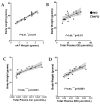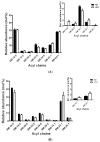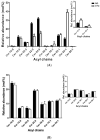Obese Mice with Dyslipidemia Exhibit Meibomian Gland Hypertrophy and Alterations in Meibum Composition and Aqueous Tear Production
- PMID: 33233559
- PMCID: PMC7699756
- DOI: 10.3390/ijms21228772
Obese Mice with Dyslipidemia Exhibit Meibomian Gland Hypertrophy and Alterations in Meibum Composition and Aqueous Tear Production
Abstract
Background: Dyslipidemia may be linked to meibomian gland dysfunction (MGD) and altered meibum lipid composition. The purpose was to determine if plasma and meibum cholesteryl esters (CE), triglycerides (TG), ceramides (Cer) and sphingomyelins (SM) change in a mouse model of diet-induced obesity where mice develop dyslipidemia.
Methods: Male C57/BL6 mice (8/group, age = 6 wks) were fed a normal (ND; 15% kcal fat) or an obesogenic high-fat diet (HFD; 42% kcal fat) for 10 wks. Tear production was measured and meibography was performed. Body and epididymal adipose tissue (eAT) weights were determined. Nano-ESI-MS/MS and LC-ESI-MS/MS were used to detect CE, TG, Cer and SM species. Data were analyzed by principal component analysis, Pearson's correlation and unpaired t-tests adjusted for multiple comparisons; significance set at p ≤ 0.05.
Results: Compared to ND mice, HFD mice gained more weight and showed heavier eAT and dyslipidemia with higher levels of plasma CE, TG, Cer and SM. HFD mice had hypertrophic meibomian glands, increased levels of lipid species acylated by saturated fatty acids in plasma and meibum and excessive tear production.
Conclusions: The majority of meibum lipid species with saturated fatty acids increased with HFD feeding with evidence of meibomian gland hypertrophy and excessive tearing. The dyslipidemia is associated with altered meibum composition, a key feature of MGD.
Keywords: dry eye; dyslipidemia; lipids; mass spectrometry; meibomian gland dysfunction; meibum; obesity.
Conflict of interest statement
The authors declare no conflict of interest.
Figures














Similar articles
-
Relationships between ocular surface sphingomyelinases, Meibum and Tear Sphingolipids, and clinical parameters of meibomian gland dysfunction.Ocul Surf. 2022 Jul;25:101-107. doi: 10.1016/j.jtos.2022.06.003. Epub 2022 Jun 14. Ocul Surf. 2022. PMID: 35714913
-
Changes in Human Meibum Lipid Composition Related to the Presence and Severity of Meibomian Gland Dysfunction.J Ocul Pharmacol Ther. 2024 Nov;40(9):562-570. doi: 10.1089/jop.2024.0063. Epub 2024 Aug 16. J Ocul Pharmacol Ther. 2024. PMID: 39150383 Free PMC article.
-
Meibum sphingolipid composition is altered in individuals with meibomian gland dysfunction-a side by side comparison of Meibum and Tear Sphingolipids.Ocul Surf. 2022 Jan;23:87-95. doi: 10.1016/j.jtos.2021.11.011. Epub 2021 Nov 30. Ocul Surf. 2022. PMID: 34861426 Free PMC article.
-
[The role of meibum proteins in the pathogenesis of meibomian gland dysfunction].Vestn Oftalmol. 2025;141(1):70-75. doi: 10.17116/oftalma202514101170. Vestn Oftalmol. 2025. PMID: 40047025 Review. Russian.
-
Meibomian Gland Dysfunction and Contact Lens Discomfort.Eye Contact Lens. 2017 Jan;43(1):17-22. doi: 10.1097/ICL.0000000000000351. Eye Contact Lens. 2017. PMID: 28002224 Review.
Cited by
-
Effects of Aging on Human Meibum.Invest Ophthalmol Vis Sci. 2021 Sep 2;62(12):23. doi: 10.1167/iovs.62.12.23. Invest Ophthalmol Vis Sci. 2021. PMID: 34546321 Free PMC article.
-
Association of Serum Lipid Level with Meibum Biosynthesis and Meibomian Gland Dysfunction: A Review.J Clin Med. 2022 Jul 11;11(14):4010. doi: 10.3390/jcm11144010. J Clin Med. 2022. PMID: 35887773 Free PMC article. Review.
-
Alteration of Meibum Lipidomics Profiling in Patients With Chronic Ocular Graft-Versus-Host Disease.Invest Ophthalmol Vis Sci. 2023 Sep 1;64(12):35. doi: 10.1167/iovs.64.12.35. Invest Ophthalmol Vis Sci. 2023. PMID: 37733365 Free PMC article.
-
Meibomian gland stem/progenitor cells: The hunt for gland renewal.Ocul Surf. 2023 Jul;29:497-507. doi: 10.1016/j.jtos.2023.07.004. Epub 2023 Jul 6. Ocul Surf. 2023. PMID: 37422152 Free PMC article.
-
The Effect of BMI on Blood Lipids and Dyslipidemia in Lactating Women.Nutrients. 2022 Dec 5;14(23):5174. doi: 10.3390/nu14235174. Nutrients. 2022. PMID: 36501203 Free PMC article.
References
-
- Office of the General Surgeon of the United States. The Offcie of Disease Prevention. Health Promotion. Centers for Disease Control and Prevention . The Surgeon General’s Call to Action to Prevent and Decrease Overweight and Obesity. US Government Printing Office; Washington, DC, USA: 2001.
MeSH terms
Substances
Grants and funding
LinkOut - more resources
Full Text Sources
Medical
Miscellaneous

